

Sticker shock
 |
As cities grow and redevelop, new buildings are built, and it seems as if we're always hearing about construction workers unearthing ancient remains or other remnants of previous civilizations. All work is halted as archaeologists swoop in to get a better look and to protect and preserve the findings, which invariably will end up on display somewhere, with circles and arrows and all sorts of descriptive comments.
I know the feeling.
During our recent move to consolidate several departments of NHRA Publications, we had our own unearthing of ancient artifacts. No, it wasn't fossilized remains of old race car skeletons or Don Garlits' silver collection, but a treasure trove of old drag racing stickers that had been applied over the decades (I'm assuming by our late, great photo editor, Leslie Lovett) to several filing cabinets in the Photo Department. The side of one of the cabinets had been against a wall for the last two decades and the other tucked away in the deep recesses of the old darkroom. Because these are fireproof cabinets – lined in concrete – they're not easily moved, so until we began the great Downstairs Migration of 2011, their secrets lay hidden.
Stickers are one of drag racing's original promotional items and have been eagerly sought by racers and fans to decorate their race cars, tow vehicles, garages, toolboxes, and bedrooms. Even today, you can see kids racing from booth to booth in the Manufacturers Midway at NHRA national events, tote bags in hand, collecting stickers by the dozen to adorn their folders and book covers or to trade for, say, a peanut butter and jelly sandwich at lunch.
Stickers (or decals, as they also are often called), of course, are a major component of NHRA's contingency awards program. Although many a racer would probably proudly fly a product decal on his or her car to boast of the component, he or she is also paid for wins and runners-up by those companies if using the product and flying the decal. It's a great form of advertising for those companies and a lucrative deal for the racer who shops according to the major-sponsor list.
 Let's take a look at what I found; I'll do this in two parts, cabinet by cabinet, and photographed for me by our own Marc Gewertz. As you can see above, there are a lot of decals. I won’t be able to address them all, but I hope to hit the highlights.
Let's take a look at what I found; I'll do this in two parts, cabinet by cabinet, and photographed for me by our own Marc Gewertz. As you can see above, there are a lot of decals. I won’t be able to address them all, but I hope to hit the highlights.
Some of the most interesting (well, to me) decals are the various event-specific stickers at right. These typically are given to contestants at the events to display on their race cars, but Lovett always grabbed extras to use as labels for the proof books that contain reference pages for the photo negatives of the vast number of black and white photos that were shot at each event.
The 1968 Winternationals decal has a very simple design, with the event name, date, and venue surrounding the NHRA logo. It’s easy on the eyes, which can’t really be said for the 1970 World Finals logo, with its shocking black and orange scheme that seems better suited to viewing under a black light than dragstrip lights.
The 1970 schedule, as many will recall, was NHRA’s vaunted “Super Season,” in which the schedule nearly doubled, from four events to seven, with the addition of the Gatornationals, Summernationals (held that year in York, Pa.), and the Supernationals at Ontario Motor Speedway. The sticker from that 1970 York event was no less “eye-catching” (to put it politely) than the Finals decal, with a curious choice of pink and yellow. Maybe it was the influence of pastel colors from that era. Judge for yourselves.
 |
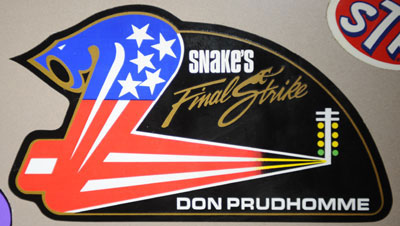 |
 |
As a longtime and ardent fan of wheelstander king “Wild Bill” Shrewsberry, I love this decal. Some of you may remember that I interviewed him a few years ago for this column, and I finally got to meet him face to face last summer at one of the get-togethers at Don Prudhomme’s shop.
I’m not certain what one received as a member of his official fan club, but I know that those of us who were in his unofficial fan club received a lifetime of thrills and memories from watching his famed candy-striped L.A. Dart wheelstander walk the track on its hind legs.
Speaking of “the Snake,” you gotta admit that cool logos have always been a hallmark of his operation. From the original coiled cobra through the star-spangled snake of the Army years all the way through (and beyond) his retirement, he has always had great taste in selecting the logo to represent him (note to self: Find out who created the original “Snake” and “Mongoose” caricatures), and this one, from his Final Strike season in 1994, is no exception.
Prudhomme went out in style that year not just on the track – where he scored three wins and two runner-ups and finished second (his best finish in Top Fuel) behind Scott Kalitta – but with this stylish design. I found it interesting that although he was years removed from his Army deal, this modernized snake is still red, white, and true. The nice trail of yellow streaks from the Christmas Tree to the tail is great, and incorporating a snake in the “S” of "Strike" is awesome. The only thing that would have made this better for me would have been the inclusion of the year in the design.
Of course, you can’t talk about “the Snake” without discussing his lifetime rival, Tom McEwen. The vaunted “Mongoose” was one of the sport’s sharpest promotionally minded drivers, and one probably not matched or exceeded until Kenny Bernstein brought his considerable business acumen to the track or John Force his good-old-boy charm and charisma. McEwen grasped it all, learning how to work with sponsors, how to get his name out there win, lose, or draw, even if that meant playing the villain.
McEwen was definitely from the school of thought that says, “I don’t care what you write about me as long as you spell my name right” (which many couldn’t!), but he also knew how to merchandise and take care of people. He was always especially good to the press – showering them with gifts (including nice team jackets) and hosting media get-togethers – in appreciation for their efforts to publicize his accomplishments, and even today, he calls me about once a month to make sure I’m up to speed on whatever breaking news and rumors are out there.
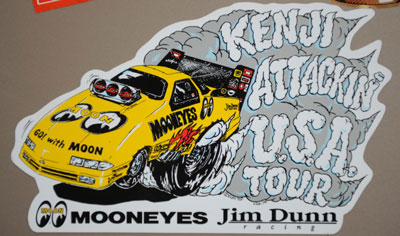 |
This is another great effort that salutes the efforts of Japanese racer Kenji Okazaki, who wheeled “Big Jim” Dunn’s Mooneyes Funny Car for several years on the NHRA tour. I’m sure it’s no accident that the “Kenji Attackin’ USA Tour” harkens back in tone to all of the old Tokyo disaster movies in which the great city was attacked by oversized lizards, pteranodons, moths, sea monsters, and other radioactively rendered creatures. The artwork, for which "Ken" is credited on the sticker, is lively and vibrant, and although Okazaki didn’t exactly lay waste to the competition like Godzilla in Tokyo, he did do some considerable damage, including a sixth-place finish in 1993 and other top 10 finishes in 1996 (eighth) and 1997 (ninth). His 1993 campaign was highlighted by a final-round appearance at the biggest race of ’em all, the U.S. Nationals (he was unable to contest the final vs. Force due to breakage), and he made big news in 1997 with his victory in Englishtown, where he became the first Japanese racer to win a major NHRA event. I think he started out as a great curiosity to many of us – most of whom predicted that the relationship between him and the sometimes brusque Dunn would never survive their first pass – and turned out to be a great driver who earned the respect of his peers as a “tough out.”
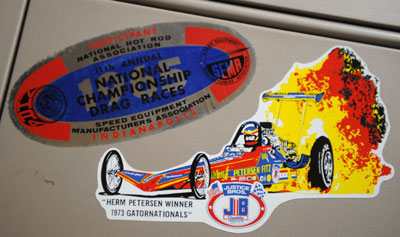 |
This is a combo photo only because I couldn’t find a way to separate the two without some Photoshop trickery, and Lovett took full advantage of the unique cutout design of the dragster decal to fit the event logo. The dragster decal salutes the victory by Herm Petersen at the 1973 Gatornationals, the only NHRA win by “the Northwest Terror,” with a fire-burnout image. Petersen’s career, of course, was significantly derailed by injuries suffered later that year in a nasty crash and resultant fire at Orange County Int’l Raceway. I remember buying a poster at the track later that year to help defray his medical costs that also featured the car doing a fire burnout (which I remember thinking was an unfortunate choice), which may have been the image used to create this decal. Petersen did rebound to heroically reach the final of the 1975 World Finals, but people seem to forget that, probably because of the histrionics of event winner Garlits in running his fabled 5.63, 250 pass. The other part of this dual-decal image is a logo trying way too hard to do too much. It’s from the 1965 Nationals in Indianapolis and also includes a logo and text for SEMA.
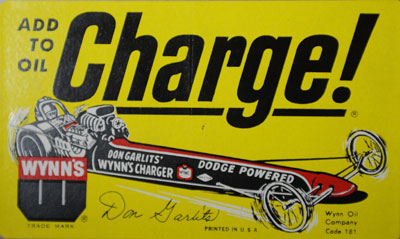 |
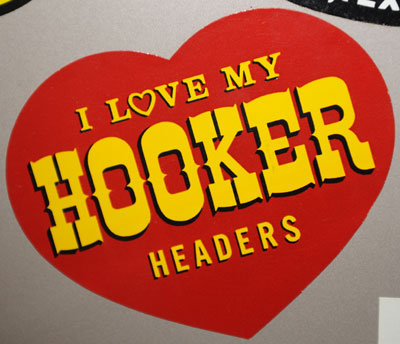 |
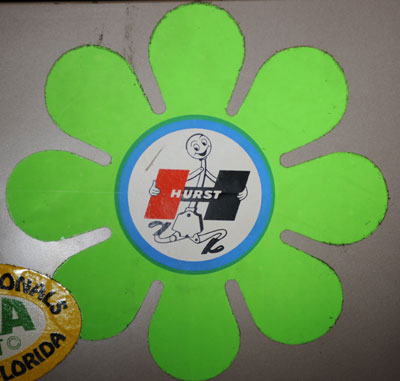 |
 |
Here’s a pretty rare one, if for no other reason than it shows Garlits’ dragster in one of the few instances in which his vaunted Swamp Rat is not painted purely in black. Wynn’s had a long association with “Big Daddy,” dating back to 1966, and this decal, which I think is from 1967, celebrates their partnership. Even though Garlits states that this car (Swamp Rat X, which originally was painted all red) also was driven on several occasions by Emory Cook that year, the decal still bears “Big’s” signature. The Wynn’s logo then was a black and red W and not the well-remembered elongated rainbow oval surrounding the company name.
And speaking of memorable logos, there may be no more iconic hard-parts logo in the high-performance world than the bright red heart of Hooker Headers and the vaguely suggestive tagline “I love my Hooker Headers.” Although the company took full advantage of its provocative-sounding name, it came by it honestly through company founder Gary Hooker, who in 1962 designed a header for his new 409 Chevrolet. Word spread quickly among his fellow racers, and before long, a business was created. The company employed other slogans – “When Only The Best Will Do," “Do It Right The First Time" -- but few could have been as popular as the love slogan. I’m not sure which genius designed the logo, but you can spot that heart from a quarter-mile away. It seemed to be included on the decal sheet of every model car I ever built, and as my world expanded beyond plastic parts in a box to the real thing at the dragstrip, I found the logo no less ubiquitous.
The Hooker logo screams 1970s, as does this interesting design from the folks at Hurst, which takes full advantage of the popular flower-power motif of the late 1960s and early 1970s. With Day-Glo green petals surrounding what I assume is an anthropomorphized Hurst shifter with linkage for legs holding the familiar red and black H, it’s definitely a funky decal, and I’m not sure I ever recall seeing it on anyone’s car (it’s also fairly large, measuring 7 1/2 inches square). Hurst, founded in 1958 by George Hurst, was one of NHRA’s earliest supporters, and the on-site tech support (“the Shifty Doctor,” Jack “Doc” Watson) and its at-track “hospital” repair facility were groundbreakers for the sport that today are taken for granted.
And lastly, for today, is this decal for the Crane Cams 250-mph Club for Funny Cars. I’m not sure if this was the decal worn by drivers in the club or one made to publicize it, but the former group was limited to eight drivers. Cragar had already established the idea of corporate-sponsored performance clubs with its Five-Second Clubs for Top Fuelers and Funny Cars, and NHRA itself funded the 250-mph Club for Top Fuelers. Announced in the May 1, 1981, issue of National DRAGSTER, it took more than a year for the 250-mph Funny Car Club to get its first member. On May 29, 1982, Prudhomme made a run of 250.00 in qualifying at the Cajun Nationals, and it took more than another year to fill the club’s roster. In order, the club members are Billy Meyer (July 17, 1982, 250.69, Englishtown), Ken Veney (Sept. 4, 1982, 254.23, Indianapolis), Tripp Shumake (Oct. 3, 1982, 250.00, Fremont, Calif.), Mark Oswald (March 11, 1983, 254.23, Gainesville); Dale Pulde (July 10, 1983, 252.80, Milan, Mich.), Raymond Beadle (July 10, 1983, 251.39, Milan), and Force (Sept. 3, 1983, 250.69, Indianapolis).
OK, that’s it for the first half of the sticker showoff, and I’m assuming that I’ll quickly be besieged with your own photos of cool decals. In fact, I’m not assuming, I’m expecting. I know the way you guys are. If you’re going to send something, please take as clear and well-lit a photo as you can and provide whatever details you have of either the sticker or where/when you got it. “Stick” around ... there’s more to come Friday.



















































